Scenario: A Citrix Architect is asked by management at the Workspacelab organization to review their existing configuration and make the necessary upgrades. The architect recommends small changes to the pre-existing Citrix ADC configuration. Currently, the Citrix ADC MPX devices are configured in a high availability pair, and the outbound traffic is load balanced between two Internet service providers (ISPs). However, the failover is NOT happening correctly. The following requirements were discussed during the design requirement phase:
• The return traffic for a specific flow should be routed through the same path while using Link Load Balancing.
• The link should fail over even if the ISP router is up and intermediary devices to an ISP router are down.
• Traffic going through one ISP router should fail over to the secondary ISP, and the traffic should NOT flow through both routers simultaneously. What should the architect configure to meet this requirement?
Which three session settings are valid once a Citrix Architect has configured session settings to customize user sessions? (Choose three.)
A Citrix Architect needs to configure advanced features of NetScaler by using StyleBooks as a resource in the Heat service.
What is the correct sequence of tasks to be completed for configuring NetScaler using the Heat stack?
Scenario: A Citrix Architect needs to configure a Content Switching virtual server to provide access to . However, the architect observes that whenever the user tries to access , the user receives a "503 - Service Unavailable" response. The configuration snippet is as follows:

What should the architect modify to resolve this issue?
Scenario: A Citrix Architect needs to assess a NetScaler Gateway deployment that was recently completed by a customer and is currently in pre-production testing. The NetScaler Gateway needs to use ICA proxy to provide access to a XenApp and XenDesktop environment. During the assessment, the customer informs the architect that users are NOT able to launch published resources using the Gateway virtual server.
Click the Exhibit button to view the troubleshooting details collected by the customer.

What is the cause of this issue?
Which encoding type can a Citrix Architect use to encode the StyleBook content, when importing the StyleBook configuration under source attribute?
Which markup language can a Citrix use along with NITRO API to create a StyleBook?
What are three potential risks when examining the disaster recovery plan and implementation for a company? (Choose three)
Scenario: A Citrix Architect needs to design a new NetScaler Gateway deployment for a customer. During the design discussions, the architect learns that the customer would like to allow external RDP connections to internal Windows machines but does NOT want client drive redirection enabled on these connections.
Where should the architect enable the options to allow the customer to complete their requirement?
Scenario: A Citrix Architect needs to assess an existing on-premises NetScaler deployment which includes Advanced Endpoint Analysis scans. During a previous security audit, the team discovered that certain endpoint devices were able to perform unauthorized actions despite NOT meeting pre-established criteria.
The issue was isolated to several endpoint analysis (EPA) scan settings.
Click the Exhibit button to view the endpoint security requirements and configured EPA policy settings.
Which setting is preventing the security requirements of the organization from being met?
Scenario: A Citrix Architect and a team of Workspacelab members met to discuss a NetScaler design project. They captured the following requirements from this design discussion:
Click the Exhibit button to review the logical network diagram.
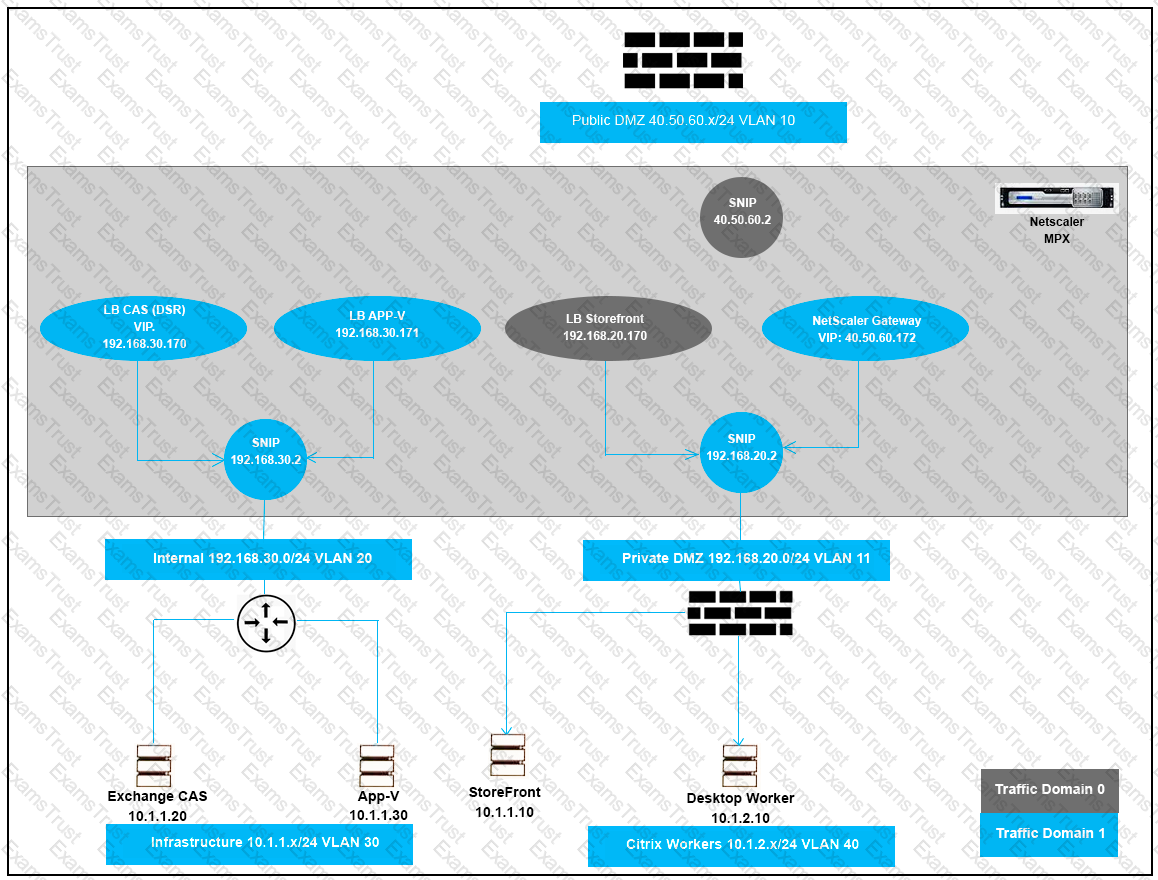
Which two design decisions are incorrect based on these requirements? (Choose two.)
Scenario: More than 10,000 users will access a customer’s environment. The current networking infrastructure is capable of supporting the entire workforce of users. However, the number of support staff is limited, and management needs to ensure that they are capable of supporting the full user base.
Which business driver is prioritized, based on the customer’s requirements?
For which two reasons should a Citrix Architect perform a capabilities assessment when designing and deploying a new Citrix ADC in an existing environment? (Choose two.)
What can help a Citrix Architect prepare to discuss time scales and resource requirements?
Which two NetScaler cookies indicate the validity of the Authentication, Authorization and Accounting (AAA) session for users? (Choose two.)
Scenario: The Workspacelab team has implemented a Citrix ADC high availability pair and Citrix ADC Management and Analytics (Citrix Application Delivery Management). The Citrix Application Delivery Management was configured by a Citrix Architect to monitor and manage these devices. The Workspacelab team wants to load balance their Microsoft SharePoint servers on the Citrix ADC and needs the process to be streamlined and administered using Citrix Application Delivery Management. The following requirements were discussed during the meeting.
• The Microsoft SharePoint server should be optimized. Load balanced, and secured in the network and should be deployed using Citrix Application Delivery Management.
• All the configurations should be verified before getting pushed to the Citrix Application Delivery Management.
What is a prerequisite for installing Microsoft SharePoint using Citrix Application Delivery Management?
Scenario: A Citrix Architect has deployed Citrix Gateway integration with the StoreFront server. The Vasco server is used to perform WebAUTH to authenticate users The configuration snippet is as follows:

Which parameter is utilized to calculate the content-length insert in the request sent to the server?
Scenario: A Citrix Architect needs to design a new Citrix ADC Gateway deployment to provide secure RDP access to backend Windows machines.
Click the Exhibit button to view additional requirements collected by the architect during the design discussions.

To meet the customer requirements, the architect should deploy the RDP proxy through _______, using a _________ solution. (Choose the correct option to complete the sentence.)
Which two types of database deployments are supported in Citrix Application Delivery Management? (Choose two.)
Scenario: A Citrix Architect needs to assess an existing NetScaler multi-site deployment. The deployment is using Global Server Load Balancing (GSLB) configured in a parent-child configuration.
Click the Exhibit button to view the diagram of the current GSLB configuration and parent-child relationships, as well as the status of the sites and the connectivity between them.
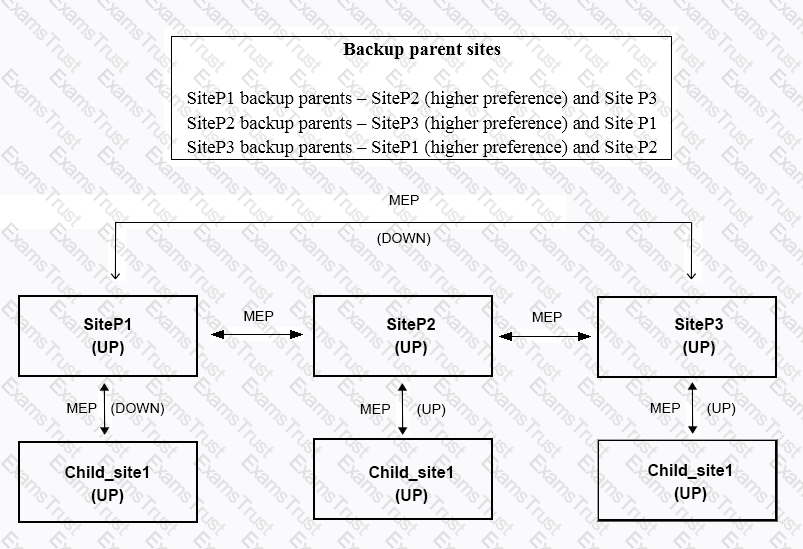
Based on the displayed configuration and status, Child_site1_______ a connection from _______. (Choose the correct option to complete the sentence.)
Scenario: Based on a discussion between a Citrix Architect and a team of Workspacelab members, the MPX Logical layout for Workspacelab has been created across three (3) sites.
The requirements captured during the design discussion held for a NetScaler design project are as follows:
How many Citrix ADC MPX appliances should the architect deploy at each site to meet the design requirements above?
Which two features are supported on LbaaSV1? (Choose two.)
Which three methods can a Citrix Architect use to assess the capabilities of a network infrastructure? (Choose three.)
Scenario: A Citrix Architect needs to assess an existing NetScaler Gateway deployment. During the assessment, the architect collected key requirements for VPN users, as well as the current session profile settings that are applied to those users.
Click the Exhibit button to view the information collected by the architect.
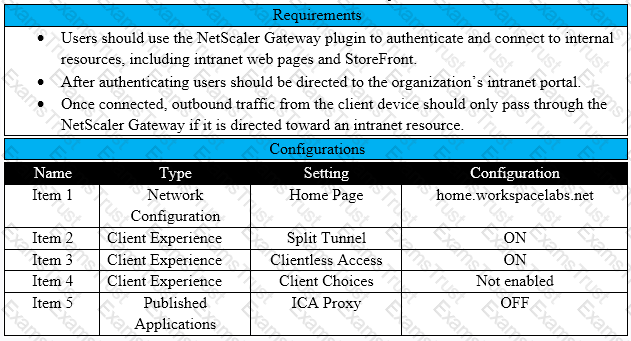
Which configurations should the architect change to meet all the stated requirements?
Which StyleBook group should a Citrix Architect use to deploy the configuration for Microsoft SharePoint servers on Citrix ADC Management and Analytics (Citrix Application Delivery Management)?
Scenario: A Citrix Architect needs to design a hybrid XenApp and XenDesktop environment which will include Citrix Cloud as well as resource locations in an on-premises datacenter and Microsoft Azure.
Organizational details and requirements are as follows:
Click the Exhibit button to view the conceptual environment architecture.
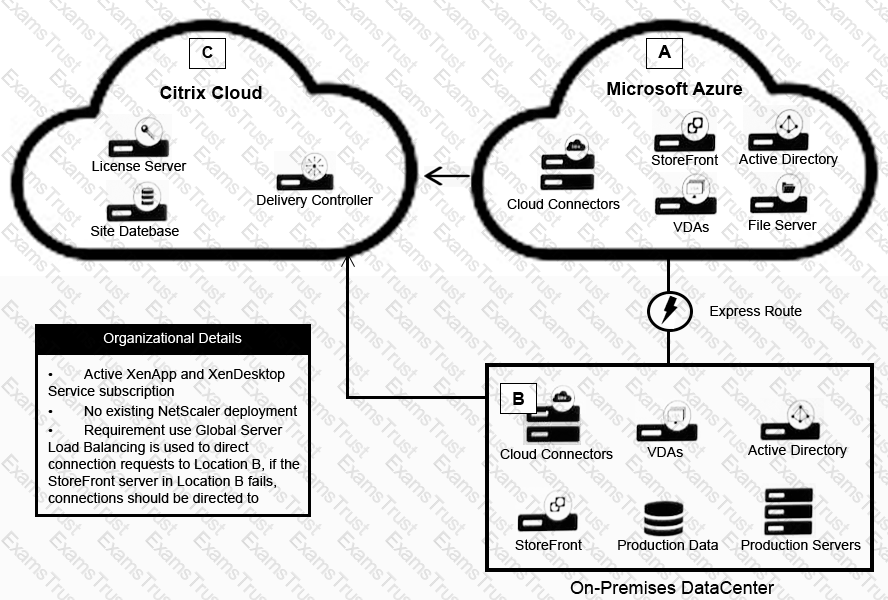
The architect should use _____ in Location A, and should use ________ in Location B. (Choose the correct option to complete the sentence.)
Scenario: A Citrix Architect has met with a team of Workspacelab members for a design discussion. They have captured the following requirements for the Citrix ADC design project:
Which authentication policy must the architect execute first to meet the design requirements?
Scenario: A Citrix Architect needs to design a hybrid XenApp and XenDesktop environment which will include as well as resource locations in an on-premises datacenter and Microsoft Azure.
Organizational details and requirements are as follows:
Click the Exhibit button to view the conceptual environment architecture.
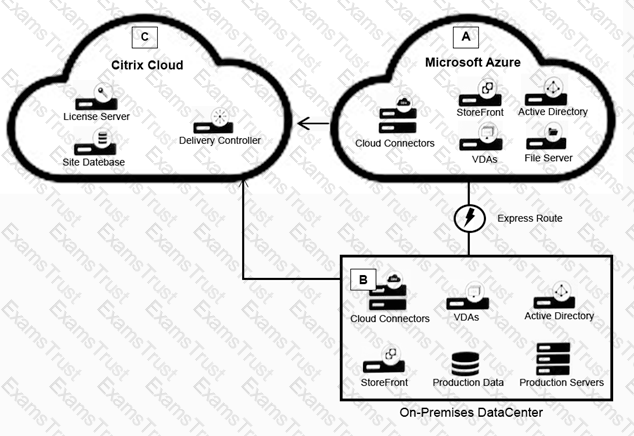
The architect should use___________ in Location A, and should use _______________ in Location B. (Choose the correct option to complete the sentence.)
Scenario: A Citrix Architect has deployed load balancing for SharePoint 2010 on a Citrix ADC instance. While editing the document, the architect observed the error displayed below:
Sorry, we couldn't open ' Documents/Citrix Enhancement Request Form.doc'
After troubleshooting, the architect discovers the issue. When a user opens a document, it opens in the browser, but while editing the document, thd session is transferred from the browser to the Word application During this time, the cookies should be transferred from the browser to the Word application.
Which two configurations should the architect modify to ensure that the cookies are shared between the browser and non-browser applications? (Choose two.)
Scenario: A Citrix Architect has sent the following request to the NetScaler:
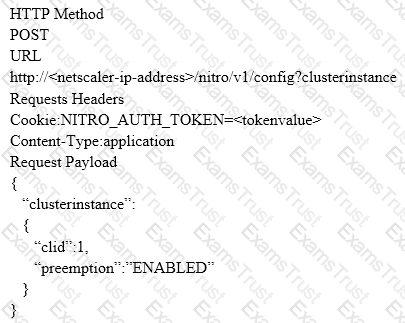
Which response would indicate the successful execution of the NITRO command?
Which four load-balancing methods support Citrix ADC Virtual Server-Level Slow Start? (Choose four.)
Which NetScaler Management and Analytics System (NMAS) utility can a Citrix Architect utilize to verify the configuration template created by the NMAS StyleBook, before actually executing it on the NetScaler?
Scenario: A Citrix Architect needs to design a new multi-datacenter Citrix ADC deployment. The customer wants Citrix ADC to provide access the various backend resources by using Global Server Load Balancing (GSLB) in an Active-Active deployment.
Click the Exhibit button to view additional requirements identified by the architect.
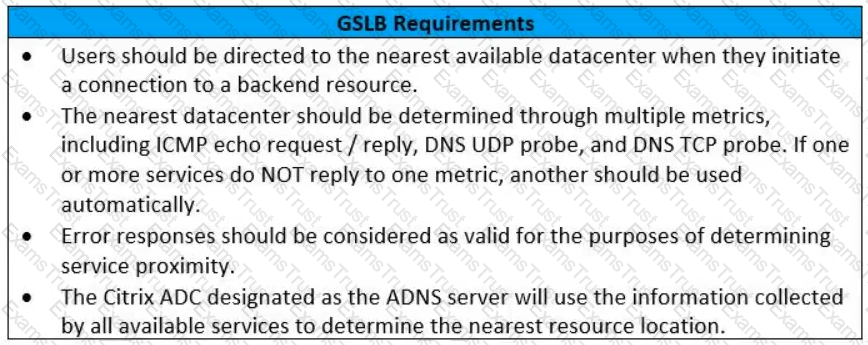
Which GSLB algorithm or method should the architect use for the deployment based on the stated requirements?
Scenario: A Citrix Architect has deployed Authentication for the SharePoint server through NetScaler. In order to ensure that users are able to edit or upload documents, the architect has configured persistent cookies on the NetScaler profile.
Which action should the architect take to ensure that cookies are shared between the browser and non-browser applications?
Scenario: Based on a discussion between a Citrix Architect and team of Workspacelab has been created across three (3) sites.
They captured the following requirements during the design discussion held for NetScaler design projects:
Which design decision must the architect make to meet the design requirements above?
Scenario: A Citrix Architect has deployed an authentication setup for the load balancing virtual server for the SAP application. The authentication is being performed using RADIUS and LDAP. RADIUS is the first factor, and LDAP is the second factor in the authentication. The Single Sign-on with SAP application should be performed using LDAP credentials. Which session profile should be used to perform the Single Sign-on?
Which two settings should a Citrix Architect use on Citrix Application Delivery Management for configuring CPX using a pre-existing CPX device? (Choose two.)
Which parameter indicates the number of current users logged on to the Citrix gateway?
Which three tasks can a Citrix Architect select and schedule using the Citrix ADC maintenance tasks? (Choose three.)
Scenario: A Citrix Architect and a team of Workspacelab members met to discuss a Citrix ADC design project. They captured the following requirements from this design discussion:
• All three (3) Workspacelab sites (DC, NDR, and DR) will have similar Citrix ADC configurations and design.
• The external Citrix ADC MPX appliances will have Global Server Load Balancing (GSLB) configured and deployed in Active/Active mode.
• ADNS service should be configured on the Citrix ADC to make it authoritative for domain nsg.workspaceIab.com.
• In GSLB deployment, the DNS resolution should be performed to connect the user to the site with least network latency.
• On the internal Citrix ADC, load balancing for StoreFront services, Citrix XML services, and Citrix Director services must be configured.
• On the external Citrix ADC, the Gateway virtual server must be configured in ICA proxy mode.
Which GSLB method should the architect utilize to meet the design requirements?
Scenario: Based on a discussion between a Citrix Architect and a team of Workspacelab members, the MPX Logical layout for Workspacelab has been created across three (3) sites.
They captured the following requirements during the design discussion held for a Citrix ADC design project:
Which design decision must the architect make the design requirements above?
Scenario: The Workspacelab team has configured their Citrix ADC Management and Analytics (Citrix Application Delivery Management) environment. A Citrix Architect needs to log on to the Citrix Application Delivery Management to check the settings.
Which two authentication methods are supported to meet this requirement? (Choose two.)
Scenario: A Citrix Architect and a team of Workspacelab members met to discuss requirements during the design discussion for a Citrix ADC design project. Specifically, the existing Citrix ADC Configuration must be modified to meet the following authentication conditions:
• Provide users with domain drop-down page
• If the users select workspacelab.com. perform single factor authentication using LDAP
• It the users select AAATM.COM, perform two factor authentication using LDAP and RADIUS
• If the users select NSI-TEST. COM. perform SAML authentication using ADFS
What should the architect use to bind the AAA virtual server to the Citrix Gateway virtual server?
Scenario: A Citrix Architect has configured two MPX devices in high availability mode with version 12.0.53.13 nc. After a discussion with the security teamf the architect enabled the Application Firewall feature for additional protection. In the initial deployment phase, the following security features were enabled:
• IP address reputation
• HTML SQL injection check
• Start URL
• HTML Cross-site scripting
• Form-Field consistency
After deployment in pre-production, the team identifies the following additional security features and changes as further requirements:
• Application Firewall should retain the response of form field in its memory. When a client submits the form in the next request Application Firewall should check for inconsistency in the request before sending it to the web server.
• All the requests dropped by Application Firewall should get a pre-configured HTML error page with appropriate information.
• The Application Firewall profile should be able to handle the data from an RSS feed and an ATOM-based site. Click the Exhibit button to view an excerpt of the existing configuration.
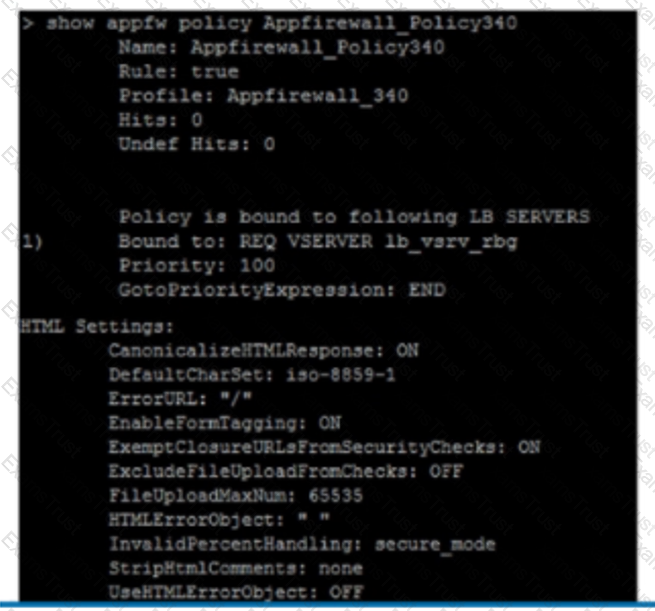
What should the architect do to meet these requirements?
Scenario: More than 10,000 users will access a customer’s environment. The current networking infrastructure is capable of supporting the entire workforce of users. However, the number of support staff is limited, and management needs to ensure that they are capable of supporting the full user base.
Which two business driver is prioritized, based on the customer’s requirements?